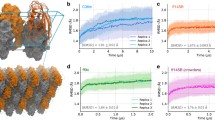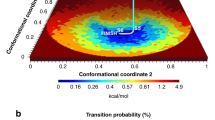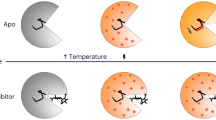Abstract
Time-resolved structural studies on biomolecular function are coming of age. Focus has shifted from studies on 'systems of opportunities' to a more problem-oriented approach, addressing significant questions in biology and chemistry. An important step in this direction has been the use of physical and chemical trapping methods to capture and then freeze reaction intermediates in crystals. Subsequent monochromatic data collection at cryogenic temperatures can produce high resolution structures of otherwise elusive intermediates. The combination of diffraction methods with spectroscopic techniques provides a means to directly correlate electronic transitions with structural transitions in the sample, eliminating much of the guesswork from experiments. Studies on cytochrome P450, isopenicillin N synthase, cytochrome cd1 nitrite reductase, copper amine oxidase and bacteriorhodopsin were selected as examples, and the results are discussed.
This is a preview of subscription content, access via your institution
Access options
Subscribe to this journal
Receive 12 print issues and online access
$189.00 per year
only $15.75 per issue
Buy this article
- Purchase on Springer Link
- Instant access to full article PDF
Prices may be subject to local taxes which are calculated during checkout




Similar content being viewed by others
References
Hajdu, J., Acharya, K. R., Barford, D., Stuart, D. I. & Johnson, L. N. Catalysis in enzyme crystals. Trends Biochem. Sci. 13, 104–109 (1988).
Hajdu, J. & Andersson, I. Fast crystallography and time-resolved structures. Annu. Rev. Biophys. Biomol. Struct. 22, 467–498 (1993).
Schlichting, I. & Goody, R.S. Triggering methods in crystallographic enzyme kinetics. Methods Enzymol. 277, 467–490 (1997).
Hadfield, A. T. & Hajdu, J. On the photochemical release of phosphate from 3,5-dinitrophenyl phosphate in a protein crystal. J. Mol. Biol. 236, 995–1000 (1994).
Brubaker, M.J., Dyer, D.H., Stoddard, B. & Koshland, D.E. Synthesis, kinetics, and structural studies of a photolabile caged isocitrate: A catalytic trigger for isocitrate dehydrogenase. Biochemistry 35, 2854–2864 (1996).
Schlichting, I., Berendzen, J., Phillips, G.N. & Sweet, R.M. Crystal-structure of photolyzed carbonmonoxy-myoglobin. Nature, 371, 808–812 (1994).
Srajer, V. et al. Photolysis of the carbon-monoxide complex of myoglobin - nanosecond time-resolved crystallography. Science 274, 1726–1729 (1996).
Genick, U.K. et al. Structure of a protein photocycle intermediate by millisecond time-resolved crystallography. Science 275, 1471–1475 (1997).
Genick, U.K., Soltis, S.M., Kuhn, P., Canestrelli, I.L. & Getzoff, E.D. Structure at 0.85 Angstrom resolution of an early protein photocycle intermediate. Nature 392, 206–209 (1998).
Stoddard, B.L. New results using Laue diffraction and time-resolved crystallography. Curr. Opin. Struct. Biol. 8, 612–618 (1998).
Perman, B. et al. Energy transduction on the nanosecond time scale: Early structural events in a xanthopsin photocycle. Science 279, 1946–1950 (1998).
Edman, K. et al. High-resolution X-ray structure of an early intermediate in the bacteriorhodopsin photocycle. Nature, 401, 822–826 (1999).
Luecke, H., Schobert, B., Richter, H.T., Cartailler, J.P. & Lanyi, J.K. Structural changes in bacteriorhodopsin during ion transport at 2 Angstrom resolution. Science 286, 255–260 (1999).
Chu, K. et al. Structure of a ligand-binding intermediate in wild-type carbonmonoxy myoglobin. Nature 403, 921–923 (2000).
Royant, A. et al. Helix deformation is coupled to vectorial proton transport in the photocycle of bacteriorhodopsin. Nature 406, 645–648 (2000).
Sass, H.J. et al. Structural alterations for proton translocation in the M state of wild type bacteriorhodopsin. Nature 406, 649–653 (2000).
Schlichting, I. et al. The catalytic pathway of cytochrome P450cam at atomic resolution. Science 287, 1615–1622 (2000).
Larsson, J. et al. Ultrafast structural changes measured by time-resolved X-ray diffraction. App. Phys. A 66, 587–591 (1998).
Rischel, C. et al. Femtosecond time-resolved X-ray diffraction from laser-heated organic films. Nature 390, 490–492 (1997).
Neutze, R. & Hajdu, J. Femtosecond time resolution in X-ray diffraction experiments. Proc. Natl. Acad. Sci. USA. 94, 5651–5655 (1997).
Neutze, R., Wouts, R., van der Spoel, D., Weckert & E. Hajdu, J. Potential for femtosecond imaging of biomolecules with X-rays. Nature 406, 752–757 (2000).
Zewail, A.H., Femtochemistry: Atomic-scale dynamics of the chemical bond. J. Phys. Chem. A104, 5660–5694 (2000).
Gouet, P et al. Ferryl intermediates of catalase captured by time-resolved Weissenberg crystallography and UV-VIS spectroscopy. Nature Struct. Biol. 3, 951–956 (1996).
Williams, P.A. et al. Heme ligand-switching during catalysis in crystals of a nitrogen cycle enzyme. Nature, 389, 406–412 (1997).
Wilmot, C.M., Hajdu, J., McPherson, M.J., Knowles, P.F. & Phillips, S.E.V., Direct visualisation of dioxygen bound to a mononuclear copper centre during enzyme catalysis. Science 286, 1724–1728 (1999).
Burzlaff, N.I et al. The reaction cycle of isopenicillin N synthase observed by X-ray diffraction. Nature 401, 721–724 (1999).
Hajdu, J. et al. Catalysis in the crystal: Synchrotron radiation studies with glycogen phosphorylase b. EMBO J. 6, 539–546 (1987).
Hajdu, J. et al. Millisecond X-ray diffraction: First electron density map from Laue photographs of a protein crystal. Nature 329, 178–181 (1987).
Fülöp, V. et al. Laue diffraction study on the structure of cytochrome c peroxidase compound I. Structure 2, 201–208 (1994).
Moffat, K. Time-resolved crystallography. Acta Crystallogr. A 54, 833–841 (1998).
Hadfield, A. T. & Hajdu, J. A fast and portable micro-spectrophotometer for time-resolved X-ray diffraction experiments. J. Appl. Crystallogr. 26, 839–842 (1993).
Mozzarelli, A. & Rossi, G.L. Protein function in the crystal. Annu. Rev. Biophys. Biomol. Struct. 25, 343–365 (1996).
Ren, Z. et al. Laue crystallography: coming of age. J. Synchrotron Rad. 6, 891–917 (1999).
Cruickshank, D. W. J., Helliwell, J. R. & Moffat, K. Multiplicity distribution of reflections in Laue diffraction. Acta Crystallogr. A 43, 656–674 (1987).
Clifton, I. J., Elder, M. & Hajdu, J. Experimental strategies in Laue crystallography. J. Appl. Crystallogr. 24, 267–277 (1991).
Fülöp, V., Moir, J. W. B., Ferguson, S. J. & Hajdu, J. The anatomy of a bifunctional enzyme: structural basis for reduction of oxygen to water and synthesis of nitric oxide by cytochrome cd1 . Cell 81, 369–377 (1995).
Elove, G. A., Bhuyan, A. K. & Roder, H., Kinetic mechanism of cytochrome-c folding - involvement of the heme and its ligands. Biochemistry 33, 6925–6935 (1994).
Ranghino, G. et al. Quantum mechanical interpretation of nitrite reduction by cytochrome cd1 nitrite reductase from Paracoccus pantotrophus. Biochemistry 39, 10958–10966 (2000).
Allen, J.W.A., Watmough, N.J. & Ferguson, S.J., A switch in heme axial ligation prepares Paracoccus pantotrophus cytochrome cd1 for catalysis, Nature Struct. Biol. 7, 885–888 (2000).
Klinman, J.P. Mechanisms whereby mononuclear copper proteins functionalize organic substrates. Chem. Rev. 96, 2541–2561 (1996)
Wilmot C.M. et al. The catalytic mechanism of the quinoenzyme amine oxidase from Escherichia coli: Exploring the reductive half-reaction. Biochemistry 36, 1608–1620 (1997).
Su, Q. & Klinman, J.P., Probing the mechanism of proton coupled electron transfer to dioxygen: the oxidative half-reaction of bovine serum amine oxidase. Biochemistry 37, 12513–12525 (1998).
Roach, P. L. et al. The crystal structure of isopenicillin N synthase, first of a new structural family of enzymes. Nature, 375, 700–704 (1995).
Subramanian, S & Henderson, R. Molecular mechanism of vectorial proton translocation by bacteriorhodopsin. Nature 406, 653–657 (2000).
Luecke, H. et al. Coupling photoisomerisation of retinal to directional transport in bacteriorhodopsin. J. Mol. Biol. 300, 1237–1255 (2000).
Vonk, J. Structure of the bacteriorhodopsin mutant F219L N intermediate revealed by electron crystallography. EMBO J. 19, 2152–2160 (2000).
Szöke, A. Time-resolved holographic diffraction at atomic resolution. Chem. Phys. Lett. 313, 777–788 (1999).
Szöke, A. Holographic methods in X-ray crystallography. 2. Detailed theory and connection to other methods of crystallography. Act. Crystallogr. A 49, 853–866 (1993).
Somoza, J.R. et al. Holographic methods in X-ray crystallography 4. A fast algorithm and its application to macromolecular crystallography. Acta Crystallogr. A 51, 691–708 (1995).
Faigel, G. & Tegze, M. X-ray holography. Rep. Progr. Phys. 62, 355–393 (1999).
Miao, J. W., Charalambous, P., Kirz, J. & Sayre, D. Extending the methodology of X-ray crystallography to allow imaging of micrometre-sized non-crystalline specimens. Nature 400, 342–344 (1999).
Winick, H., The linac coherent light source (LCLS): A fourth-generation light source using the SLAC linac. J. Elec. Spec. Rel. Phenom. 75, 1–8 (1995).
Wiik, B. H. The TESLA project: an accelerator facility for basic science. Nucl. Inst. Meth. Phys. Res. B398, 1–8 (1997).
Parsons M.R. et al. Crystal structure of a quinoenzyme: copper amine oxidase of Escherichia coli at 2 Å resolution. Structure 3, 1171–1184 (1995).
Belrhali et al., Protein, lipid and water organization in bacteriorhodopsin crystals: a molecular view of the purple membrane at 1.9 Å resolution. Structure 7, 909–917 (1999).
Acknowledgements
This work was supported by the Swedish Research Councils, the EU-Biotech Programme STINT, EMBO and the BBSRC Structural Biology Initiative.
Author information
Authors and Affiliations
Corresponding authors
Rights and permissions
About this article
Cite this article
Hajdu, J., Neutze, R., Sjögren, T. et al. Analyzing protein functions in four dimensions. Nat Struct Mol Biol 7, 1006–1012 (2000). https://doi.org/10.1038/80911
Received:
Accepted:
Issue Date:
DOI: https://doi.org/10.1038/80911
This article is cited by
-
Enzyme intermediates captured “on the fly” by mix-and-inject serial crystallography
BMC Biology (2018)
-
Structures of riboswitch RNA reaction states by mix-and-inject XFEL serial crystallography
Nature (2017)
-
Sequentially timed all-optical mapping photography (STAMP)
Nature Photonics (2014)
-
Bioimaging of cells and tissues using accelerator-based sources
Analytical and Bioanalytical Chemistry (2008)



